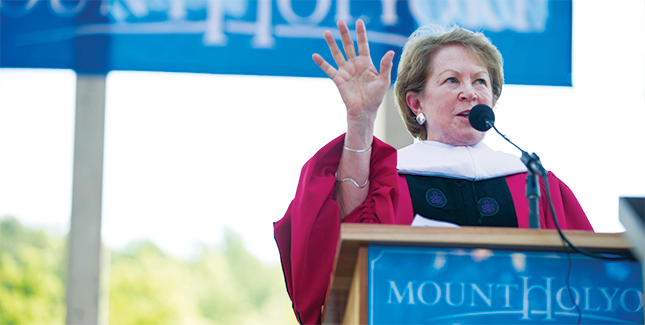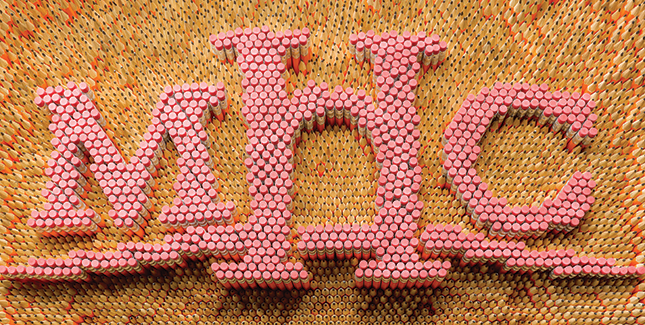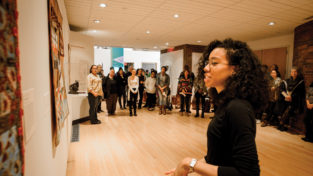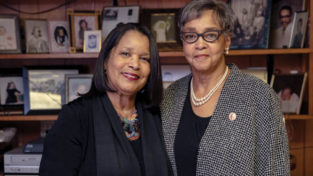On Point
Championing liberal education
On a very warm spring day last May, hundreds of graduating seniors, their families, and guests gathered in Gettell Amphitheater for the College’s 178th Commencement exercises. Perched on the edges of their seats and on the brink of embarking on the next important steps in pursuing their careers, they received one final boost of confidence that they were well prepared, no matter their chosen path.
“Mount Holyoke is breaking new ground in twenty-first-century education,” commencement speaker Carol Geary Schneider ’67 enthusiastically said. “A liberal education teaches you to look critically at the evidence before you leap to judgment, and it also challenges you to consider your options and your ethical responsibilities from other people’s points of view and not just from your own.”
Schneider is longtime president of the Association of American Colleges and Universities and an expert on American higher education. She says Mount Holyoke is setting a standard of forward-looking excellence not simply as a women’s college, but as a paragon of liberal education. Schneider makes a distinction between a “liberal education” and a “liberal-arts education.” Studying the liberal arts is just one way to pursue a liberal education, which is intended to equip citizen leaders with a wide knowledge of the world, with the intellectual capacities to make rigorous and reasoned judgments, and with an ethical compass and sense of responsibility for contributing to the world and helping to solve important problems. Schneider believes this mission is expanding, and Mount Holyoke is leading the way.
“In the twenty-first century there is a fourth dimension to liberal education,” Schneider says. “It is the notion that students ought to be able to integrate and apply their learning. By integrate, I mean that they can connect the broad knowledge, the intellectual skills, and the sense of responsibility and then actually apply those, whether it is in research, in a project, or in something within the wider community, but something where they actually rehearse a thoughtful, responsible use of their knowledge. With the Lynk program, Mount Holyoke has really stepped out ahead of most other liberal-arts colleges in saying, ‘We’re going to insist that all of our students do this.’”
Introduced in 2013, the Lynk program connects students’ academic work with practical applications of the liberal arts and sciences. In doing so, Schneider says, the program prepares learners for the professional world while sustaining the best traditions of liberal education—traditions that, in many different forms, have enriched the lives of countless Mount Holyoke alumnae.
Mount Holyoke is developing a powerful and exciting model for twenty-first-century liberal education—a model that deliberately and actively prepares college women to connect your learning with the world’s most important questions.
Carol Geary Schneider ’67 from her 2015 commencement address
Lina Rivero Cashin ’88 is a retired United States Air Force colonel and a senior policy and strategy analyst at Aerospace Corp. Her work involves writing and presenting recommendations to the Air Force and Department of Defense on how the US can better collaborate with international partners to build and deploy satellite constellations and other systems used in space. During her years at Mount Holyoke, she says, the diversity of experience and interests she saw in her peers opened her eyes to worlds she had not yet encountered.
“My freshman year,” she says “my roommate was a ballet dancer, and I was a physics major. Where does that happen? And what does it do for you? Well, what it does for you is you end up going to all the ballet and theater productions because you want to support your roommate, but then you also learn from it, and you learn that people think differently, and do different things, and are accomplished at different things.”
Eventually a double major in math and physics, Cashin, who attended Mount Holyoke on an ROTC scholarship, joined the Air Force immediately after graduation. In her first job with the Air Force, working as an analyst in an operations complex deep within the granite walls of Colorado’s Cheyenne Mountain, she used the math and physics skills she had learned in college to track space debris, helping protect satellites and other US space systems from orbital collisions. Soon the broader training she had received at Mount Holyoke—what Schneider has called the “powers of the mind”—came into play.
“As you mature in your career field,” Cashin says, “instead of being the technical operator, running the system, running the computer, making contact with the satellites or actually launching rockets, you end up using skills that are a little more diverse—to advocate, or to request funding, or to run briefings, or to teach other people.”
The practical integration of such skills with tangible, real-world projects is precisely what Schneider sees as so valuable—and prescient—about Mount Holyoke’s move toward linking academic studies with applied work.
“The notion of hands-on experience has been very much a part of the professional fields for a long time,” Schneider says. “Business students frequently develop some kind of a business strategy, often for an actual firm; education students get out there and have a supervised teaching experience; nursing students have a clinical experience and so on. And I think that it has taken a while for the humanities and social sciences in particular to figure out what applied learning looks like for them. This is where Mount Holyoke is ahead of the curve in creating an integrated program, and it’s a very exciting model for the College and for the disciplines of the arts and sciences.”

In May 2015 Carol Geary Schneider ’67, president of the Association of American Colleges and Universities, addressed graduating seniors during commencement. Photo by Tim Llewellyn
According to Schneider, the integration of applied learning in the curriculum is by no means a substitute for—but rather is in addition to—the enduring goals of a liberal education. And, as generations of Mount Holyoke students have learned, the particular details contained in a broad knowledge of the world can resonate in unexpected ways.
Seema Nanda’s FP’12 journey to Mount Holyoke was decidedly nontraditional. Born into a family that revered education—her mother and grandmother are both teachers, and many in her immediate family have advanced degrees—she herself started college later than many. She has struggled with depression, and after high school she worked various jobs near her home in Houston and occasionally took classes at a local community college. She arrived in South Hadley as a Frances Perkins scholar at the age of thirty-one and studied philosophy. She had earned some college credits after high school graduation, but she had never before felt the depth of support as a learner that she felt at Mount Holyoke. She also enjoyed what felt like greater freedom in her classes, away from the distraction—and sometimes condescension—of male peers.
Nanda felt comfortable expressing herself in Mount Holyoke classrooms. She felt empowered by her classmates and her professors, and that confidence informed her life after graduation. Though she had felt pressure to finish college before striking out on her own path, when she graduated in 2012 she thought: “Now I can do whatever I want!”
Her calling turned out to be art, and she has dedicated herself to it ever since. Nanda works in mixed media, and she has shown her creations in galleries in Houston, where she takes art classes and works part time at Girls Inc., instructing children on relational aggression and other social and behavioral topics, as she builds a career in art. She plans to apply to MFA programs in 2016.
“This whole exploration of art—and really of myself—has been very healing,” she says. “Not on its own, of course. But being recognized for my work, getting positive feedback, having people enjoy it—it’s been amazing, really. It’s something that’s very difficult to express fully. [Art] becomes something you have to do, something you’re not choosing to do. And you don’t want to stop anyway, so that’s fine!”
Nanda credits her experience at Mount Holyoke with giving her the confidence to try to make a living as an artist, and she also recalls an anthropology class that changed her life in an unexpected way.
“We read a book—Ecstasy and Healing in Nepal, I think it was called—and they talked about depression,” she says. “But in the book they called it something else. They called it ‘soul-loss.’ And I thought: That’s really accurate. That’s how it feels. And it described healing practices that I hadn’t known about before.” She read more about Shamanism and found a healer who she says was able to help her in important and lasting ways.
“That’s one very significant way that Mount Holyoke influenced my life,” she says. “If I had never read that book I would never have considered it—if I hadn’t had that exposure. I’m just glad I took that class. It’s been paying me back for a while.”
If a liberal education can change lives so directly, it can also ripple out in other ways—shifting perspectives, changing opinions, and raising awareness about the effects of individual and institutional choices.
“The notion that we have commitments beyond ourselves, responsibilities to something higher than ourselves, is an enduring theme in a liberal-arts education,” Schneider says. “We’re trying to prepare people to take ethical and societal responsibility for the use of knowledge. It’s not just that you can think things through and have a wealth of knowledge, but that you concern yourself with the ethical and social consequences of what you are doing.”
Susana Morris ’02 is a professor of English at Auburn University in Alabama. She specializes in contemporary African American and African Caribbean literature, writes about women’s stories and experiences for About News, and is a cofounder of the Crunk Feminist Collective, a blog whose contributors also include writer and activist Eesha Pandit ’03.
Like many professors, Morris often sits on doctoral committees outside of her own discipline, and it was on one of those, she says, that she was reminded again of the critical importance of both cultivating a moral imagination and developing the habit of rigorously exploring the implications of policies or innovations.
Several years ago, she says, she was on a committee in computer science for a PhD candidate who was working on voice-recognition software designed to identify a speaker’s race. The software was intended for insurance companies and medical-care providers who could use it to guide callers to specific treatments or approaches based on statistical connections between race and illness.
There’s no question that the education Mount Holyoke offers literally is transformative, filling the amazing women who study here with an infectious sense of purpose and passion you will carry with you in everything you do.
Carol Geary Schneider ’67 from her 2015 commencement address
“As you might imagine,” Morris says, “I thought this was particularly problematic. First of all, we’re not really sure why people get particular diseases. And also, how do you recognize a voice that’s racialized? I mean we all have stereotypes about what people sound like, but I’ve had cases of mistaken identity many times, where I’ve shown up and people have said, ‘You’re black? Looking at your name and hearing your voice I did not think you were black.’ Whatever that means. And no one thought this might be a problem?”
Morris believes the perspective she gained at Mount Holyoke from thinking and reading widely and discussing critical questions with a diverse collection of peers prepared her well for moments like these.
“This is where the liberal arts come in,” she says. “If you’re not intuitively asking these questions—if the discipline doesn’t have room for it—then where do you cultivate the sensibility that not only gives you the ability to create something like this software but also teaches you to think about the implications? Twenty million novels will tell you this is a bad idea. Go read Frankenstein. This is English 101!”
Bringing English 101 into the computer lab—and finding other creative ways to apply broad learning, diverse viewpoints, and a social conscience to the practical problems confronted in the real world—are what Schneider and many others believe are the keys to educational success in the twenty-first century. And it is in just this approach that Mount Holyoke has chosen to invest. As Schneider put it in her commencement address to the class of 2015: “Mount Holyoke is connecting this new focus on action learning with its long-standing strength as one of the nation’s premier research colleges. Students at Mount Holyoke aren’t asked to choose between research and real-world experience. Mount Holyoke provides the best of both.”
—By Abe Loomis
Abe Loomis is a freelance writer based in western Massachusetts.
This article appeared in the winter 2016 issue of the Alumnae Quarterly.
Editor’s note:
As the Alumnae Quarterly was about to go to press, we learned that Carol Geary Schneider ’67 will step down as president of the Association of American Colleges and Universities. She will be succeeded by Lynn Pasquerella ’80, who will continue to serve as Mount Holyoke’s president through June and assume her new role on July 1, 2016. Learn more.
January 15, 2016











Leave a Reply